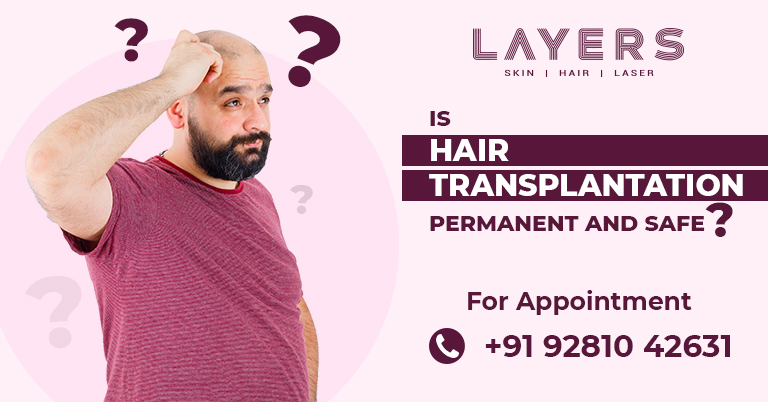Introduction
As generations cross, there will be a significant reduction in years to live, healthiness of life, and maintaining overall well-being. One of the topmost concerns that bothers individuals in this Century is hair loss. There are many reasons for hair loss to occur and impact one’s confidence but on the other hand, there are equal embracing opportunities to bring back shiny and thick hair that make it permanent, aligning with the saying – Overcoming temporary problems with permanent and safe solutions.
Hair transplantation has gained maximum traction as a permanent and most effective solution among individuals. Thanks to the trust that people have in dermatologists at Layers Clinics who stand out for delivering promising outcomes. But before investing into any medical procedure, it’s crucial to study and know about myths and misconceptions, benefits, and long-term implications of hair transplantation.
Myths and Misconceptions with Hair Transplant
While many people have fears looping in their minds about the side effects of hair transplants, we came to clear your myths and misconceptions after observing, studying, and experimenting all these years. Here are our insights and facts about hair transplantation:
Myth #1: Hair Transplants are Painful
Fact: You can expect a few discomforts during the procedure but modern hair transplant procedures such as Follicular Unit Extraction (FUE) or Follicular Unit Transplantation (FUT) are minimally invasive and well-tolerated by most patients. However, local anesthesia numbs the scalp while transplanting hair to ensure minimal pain during the surgery. Post surgery pains are managed with proper medication and care.
Myth #2: Transplanted Hair will Fallout
Fact: Worry less because it’s a natural phenomenon to lose some transplanted hair in the first few weeks after the procedure. This type of shedding, also referred to as “shock loss” is a temporary phase because hair follicles need to adapt to a new environment. It doesn’t take long for the transplanted hair to grow back in a few months and it’s clearly visible as well.
Myth #3: Hair Transplantation Leaves Scars
Fact: In our excellence towards different types of hair transplant, we observed that there’s minimal to no visible scars exist after the procedure, especially when it is FUE. If you consider FUT, thin linear scars may present but they are typically concealed by your hair. Experienced surgeons at Layers Clinics use meticulous techniques to minimize scars and ensure natural-looking results.
Myth #4: It’s a One Time Procedure
Fact: There are a lot of influencing factors depending on the intensity of transplantation and types of hair transplant techniques that may take additional sessions than expected. The number of sessions needed are influenced by the extent of hair loss, donor hair availability, and desired outcome of an individual.
Myth #5: Transplanted Hair Doesn’t Grow Naturally
Fact: When experts are involved, transplanted hair follicles have the natural ability to grow again. The direction, texture, and growth patterns of the transplanted hair will match the surrounding hair, resulting in a seamless and natural-looking appearance.
Myth #6: Hair Transplantation is Expensive
Fact: Preferring over long-term investment is better than heavy loss in short times. There are cost-effective and affordable hair transplantation treatments with exclusive offers. And with proven expertise and success in this procedure, Layers Clinics is the go-to place for regrowth of your hair.
So, understand these myths and misconceptions before being conclusive on something you are not aware of. The greater the expertise and professionalism, the better you’ll understand perceptions associated with these kinds of medical procedures.
Types of Hair Transplantation
There are four types of hair transplant techniques that make you feel shiny and youthful. These include:
1.Follicular Unit Transplantation (FUT) – In this process, a trichologist cuts a strip of scalp from the rear part of the head and dissects it into multiple grafts. This helps to achieve a set for the bald area. FUT is recommended for the people who have larger areas of emptiness on their head and who want to see massive results in less time. Also, one more concern with this treatment is it leaves scars and stitches on the head, taking longer time to heal and recover.
2. Follicular Unit Extraction (FUE) – The FUE treatment extracts individual follicular units by series from the back with the help of a tiny, specialized machine. It takes a few hours to complete with zero pain during or after the procedure. People who have less baldness or who like to go for shorter hair styles post-surgery can sign up for this. As the process is less invasive and minimum time is required, faster recovery is promised in addition to cost-effectiveness.
3. Direct Hair Transfer (DHT) – It’s a premium version of FUE where follicular units are extracted from donor area and a manual extractor is used to implant the hair at empty areas. A device called Transplanter is used to insert hair follicles into the recipient area without creating any reception holes. At Layers, DHT is proven to be 100% accurate, giving most splendid results as it’s done considering graft’s angle, depth, and direction.
4. Body Hair Transplantation (BHT) – In parallel to FUE, Body Hair Transplant deals with other parts of the body including beard, chest, stomach, arms, and legs. Once grafts are collected from these body areas, the follicles are transplanted onto the bald areas. It’s for people who suffer from extreme baldness or who have fragile hair at the back of their head.
Whatever the hair transplant treatments may be or however the person might be, Layers Clinics heads the show with the group of experts who have 20+ years of industry experience in flawless implementation of hair transplantation. If you’re the one who wants to know more about the way we do, reach and stay in touch with us as we are always Happy to Serve, Passion to Solve!

